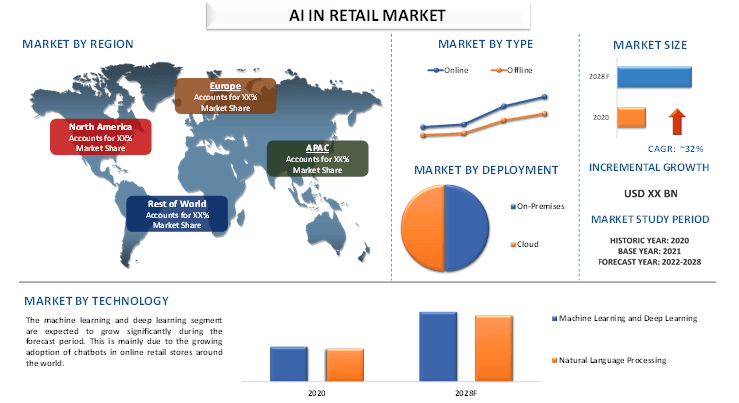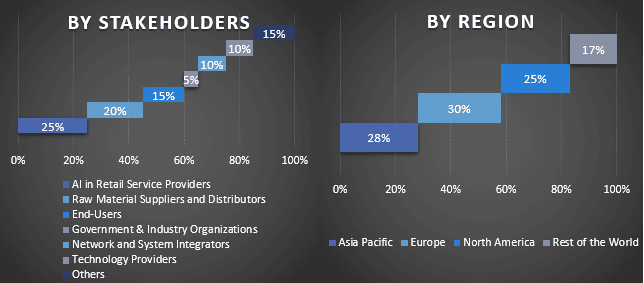- Home
- About Us
- Industry
- Services
- Reading
- Contact Us
AI In Retail Market: Current Analysis and Forecast (2022-2028)
Emphasis Type (Online and Offline); Technology [Machine Learning & Deep Learning, and Natural Language Processing (NLP)]; Deployment (On-Premises and Cloud); Application (Location-Based Marketing, Market Forecasting, In-Store visual monitoring, Advertising, Others) and Region/Country

Global AI in retail market is expected to grow at a significant rate of around 32% during the forecast period. AI in Stores is using AI and advanced algorithms to understand what a customer might be interested in based on things like demographic data, social media behavior, and purchase patterns. Using this data, they can further improve the shopping experience and personalized service, both online and in stores.
The growing adoption of AI in retail is attributed to growing internet users and smart devices, increasing awareness about AI and big data & analytics, and government initiatives towards digitization. Furthermore, the adoption of the multichannel or omnichannel retailing strategy, untapped opportunities to increase sales efficiency, enterprises’ demands for streamlining the business process, and the growing need to enhance end-user experience and take advantage of market dynamics are also contributing to the growth of the global artificial intelligence in the retail market. Moreover, the growing AI investments is also expected to significantly influence AI in Retail Market growth. For instance, in 2021, the global corporate AI investment reached 93.5 billion USD.
Amazon.com Inc, Google LLC, IBM Corporation, Intel Corporation, Microsoft Corporation, Nvidia Corporation, Oracle Corporation, SAP SE, Salesforce.com Inc, and BloomReach Inc, are some of the key players in the market. Several M&As along with partnerships have been undertaken by these players to facilitate customers with hi-tech and innovative products/technologies.
Insights Presented in the Report
“Amongst type, online category to witness robust CAGR during the forecast period”
Based on type the market is segmented into online and offline. The online segment is expected to grow with a robust CAGR during the forecast period. This is mainly because of the growing prominence of e-commerce around the globe. Online retailing includes FMCG, CPG, appeals, electronics goods, and others. Online retailing(E-commerce) offers various benefits to consumers such as convenience, due to e-commerce they don’t have to physically reach the retail stores, they can make purchases whenever they feel like it.
“Amongst technology, machine learning, and deep learning to hold a significant share in the market in 2020”
On the basis of technology, the market is segmented into machine learning & deep learning, and natural language processing (NLP). The machine learning and deep learning segment are expected to grow significantly during the forecast period. This is mainly due to the growing adoption of chatbots in online retail stores around the world. Chatbots offer various benefits such as cost savings, and contextual, AI-driven support, chatbots also help organizations to analyze consumer data in a more refined manner.
“North America to hold a significant share in the market”
In 2020, the North American region is expected to grow with a significant CAGR during the forecast period. This is mainly due to the presence of major players in the region such as Google Inc, Microsoft Corporation IBM Corporation, Salesforce, and Amazon Web Services. Moreover, the United States and Canada are the countries in the region that are the early adopters of AI technology. Also, the growing number of AI startups in the USA and Canada is expected to significantly influence the market. Furthermore, the growing investments in the research and development of AI technology in the region is expected to drive the market.
Reasons to buy this report:
- The study includes market sizing and forecasting analysis validated by authenticated key industry experts.
- The report presents a quick review of overall industry performance at one glance.
- The report covers an in-depth analysis of prominent industry peers with a primary focus on key business financials, product portfolio, expansion strategies, and recent developments.
- Detailed examination of drivers, restraints, key trends, and opportunities prevailing in the industry.
- The study comprehensively covers the market across different segments.
- Deep dive regional level analysis of the industry.
Customization Options:
The global AI in retail market can further be customized as per the requirement or any other market segment. Besides this, UMI understands that you may have your own business needs, hence feel free to connect with us to get a report that completely suits your requirements.
Table of Content
Research Methodology for the AI in Retail Market Analysis (2022-2028)
Analyzing the historical market, estimating the current market, and forecasting the future market of the global AI in retail market were the three major steps undertaken to create and analyze the adoption of AI in retail in major regions globally. Exhaustive secondary research was conducted to collect the historical market numbers and estimate the current market size. Secondly, to validate these insights, numerous findings and assumptions were taken into consideration. Moreover, exhaustive primary interviews were also conducted, with industry experts across the value chain of global AI in Retail Market. Post assumption and validation of market numbers through primary interviews, we employed a top-down/bottom-up approach to forecasting the complete market size. Thereafter, market breakdown and data triangulation methods were adopted to estimate and analyze the market size of segments and sub-segments of the industry pertains to. Detailed methodology is explained below:
Analysis of Historical Market Size
Step 1: In-Depth Study of Secondary Sources:
Detail secondary study was conducted to obtain the historical market size of the AI in Retail Market through company internal sources such as annual reports & financial statements, performance presentations, press releases, etc., and external sources including journals, news & articles, government publications, competitor publications, sector reports, third-party database, and other credible publications.
Step 2: Market Segmentation:
After obtaining the historical market size of the AI in retail market, we conducted a detailed secondary analysis to gather historical market insights and share for different segments & sub-segments for major regions. Major segments are included in the report as type, technology, deployment and application. Further country-level analyses were conducted to evaluate the overall adoption of testing models in that region.
Step 3: Factor Analysis:
After acquiring the historical market size of different segments and sub-segments, we conducted a detailed factor analysis to estimate the current market size of the AI in retail market. Further, we conducted factor analysis using dependent and independent variables such as various types, technology, deployment and application of AI in retail. A thorough analysis was conducted for demand and supply-side scenarios considering top partnerships, mergers and acquisitions, business expansion, and product launches in the AI in Retail Market sector across the globe.
Current Market Size Estimate & Forecast
Current Market Sizing: Based on actionable insights from the above 3 steps, we arrived at the current market size, key players in the global AI in Retail Market, and market shares of the segments. All the required percentage shares split, and market breakdowns were determined using the above-mentioned secondary approach and were verified through primary interviews.
Estimation & Forecasting: For market estimation and forecast, weights were assigned to different factors including drivers & trends, restraints, and opportunities available for the stakeholders. After analyzing these factors, relevant forecasting techniques i.e., the top-down/bottom-up approach were applied to arrive at the market forecast for 2028 for different segments and sub-segments across the major markets globally. The research methodology adopted to estimate the market size encompasses:
- The industry’s market size, in terms of revenue (USD) and the adoption rate of the AI in Retail Market across the major markets domestically
- All percentage shares, splits, and breakdowns of market segments and sub-segments
- Key players in the global AI in Retail Market in terms of products offered. Also, the growth strategies adopted by these players to compete in the fast-growing market
Market Size and Share Validation
Primary Research: In-depth interviews were conducted with the Key Opinion Leaders (KOLs) including Top Level Executives (CXO/VPs, Sales Head, Marketing Head, Operational Head, Regional Head, Country Head, etc.) across major regions. Primary research findings were then summarized, and statistical analysis was performed to prove the stated hypothesis. Inputs from primary research were consolidated with secondary findings, hence turning information into actionable insights.
Split of Primary Participants in Different Regions

Market Engineering
The data triangulation technique was employed to complete the overall market estimation and to arrive at precise statistical numbers for each segment and sub-segment of the global AI in Retail Market. Data was split into several segments & sub-segments post studying various parameters and trends in the areas of deployment and application in the global AI in Retail Market.
The main objective of the Global AI in Retail Market Study
The current & future market trends of global AI in the Retail Market were pinpointed in the study. Investors can gain strategic insights to base their discretion for investments on the qualitative and quantitative analysis performed in the study. Current and future market trends determined the overall attractiveness of the market at a regional level, providing a platform for the industrial participant to exploit the untapped market to benefit from a first-mover advantage. Other quantitative goals of the studies include:
- Analyze the current and forecast market size of the AI in retail market in terms of value (USD). Also, analyze the current and forecast market size of different segments and sub-segments
- Segments in the study include areas of type, technology, deployment, and application.
- Define and analysis of the regulatory framework for the AI in the retail
- Analyze the value chain involved with the presence of various intermediaries, along with analyzing customer and competitor behaviors of the industry.
- Analyze the current and forecast market size of the AI in retail market for the major region.
- Major countries of regions studied in the report include Asia Pacific, Europe, North America, and the Rest of the World.
- Company profiles of the AI in retail market and the growth strategies adopted by the market players to sustain in the fast-growing market
- Deep dive regional level analysis of the industry
Related Reports
Customers who bought this item also bought










